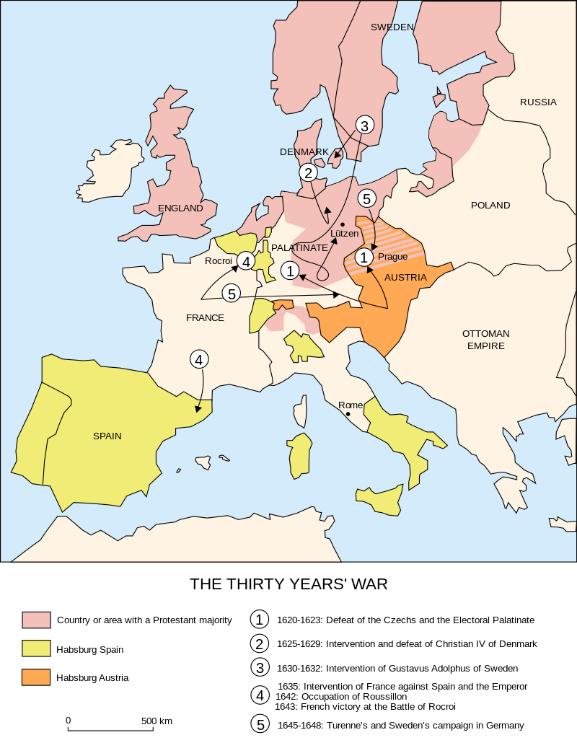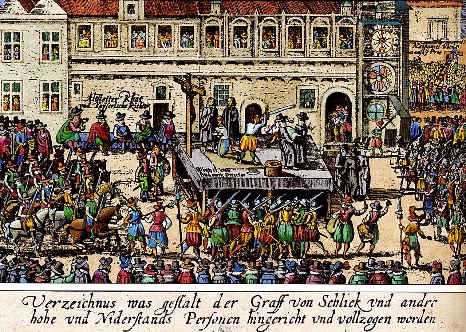
A Brief History of the World Since 1500
The idea of a nation-state was and is associated with the rise of the modern system of states, often called the “Westphalian system” in the 17th century. The balance of power that characterized that system depended on its effectiveness upon clearly defined, centrally controlled, independent entities, whether empires or nation-states, that recognized each other’s sovereignty and territory.
The Peace of Westphalia was a series of peace treaties signed between May and October 1648 in the Westphalian cities of Osnabrück and Münster. The treaties ended the Thirty Years’ War (1618-1648) in the Holy Roman Empire and the Eighty Years’ War (1568-1648) between Spain and the Dutch Republic, with Spain formally recognizing the independence of the Dutch Republic. The peace negotiations involved a total of 109 delegations representing European powers. The treaties did not restore peace throughout Europe, but they did create a basis for national self-determination.
Watch and Learn
Watch John Green explain the 17th century Crisis in Europe in Crash Course in European History #11
Background: Wars in Europe
Two destructive wars were the major triggers behind signing the eventual Peace of Westphalia: the Thirty Years’ War in the Holy Roman Empire and the Eighty Years’ War between Spain and the Dutch Republic.

Map of the Thirty Years War. (Source: Wikimedia)
The Thirty Years’ War was a series of wars in Central Europe between 1618 and 1648. Initially a war between various Protestant and Catholic states in the fragmented Holy Roman Empire, it gradually developed into a more general conflict involving most of the great powers. The war began when the newly elected Holy Roman Emperor, Ferdinand II, tried to impose religious uniformity on his domains, forcing Roman Catholicism on its peoples. The northern Protestant states, angered by the violation of their rights to choose granted in the Peace of Augsburg, banded together to form the Protestant Union. These events caused widespread fears throughout northern and Central Europe and triggered the Protestant Bohemians living in the dominion of Habsburg Austria to revolt against their nominal ruler, Ferdinand II. They ousted the Habsburgs and instead elected Frederick V, Elector of Palatinate, as their monarch. Frederick took the offer without the support of the union. The southern states, mainly Roman Catholic, were angered by this. Led by Bavaria, these states formed the Catholic League to expel Frederick in support of the emperor.
The war became less about religion and more of a continuation of the France-Habsburg rivalry for European political preeminence. Sweden, a major military power in the day, intervened in 1630 under the great general Gustavus Adolphus and started the full-scale great war on the continent. Spain, wishing to finally crush the Dutch rebels in the Netherlands and the Dutch Republic, intervened under the pretext of helping their dynastic Habsburg ally, Austria. No longer able to tolerate the encirclement of two major Habsburg powers on its borders, Catholic France entered the coalition on the side of the Protestants to counter the Habsburgs.

A woodcut showing the execution of Protestants in Prague, 1621 (Source: Wikimedia)
The Thirty Years’ War devastated entire regions, with famine and disease significantly decreasing the populations of the German and Italian states, the Crown of Bohemia, and the Southern Netherlands. The war altered the previous political order of European powers. The rise of Bourbon France, the curtailing of Habsburg ambition, and the ascendancy of Sweden as a great power created a new balance of power on the continent, with France emerging from the war strengthened and increasingly dominant in the latter part of the 17th century.
The Eighty Years’ War or Dutch War of Independence (1568-1648) was a revolt of the Seventeen Provinces against the political and religious hegemony of Philip II of Spain, the sovereign of the Habsburg Netherlands. After the initial stages, Philip II deployed his armies and regained control over most of the rebelling provinces. However, under the leadership of the exiled William the Silent, the northern provinces continued their resistance. They were eventually able to oust the Habsburg armies, and in 1581 they established the Republic of the Seven United Netherlands. The war continued in other areas, although the heartland of the republic was no longer threatened. After a twelve-year truce, hostilities broke out again around 1619, which coincided with the Thirty Years’ War.
The Peace of Westphalia
Since Lutheran Sweden preferred Osnabrück as a conference venue, its peace negotiations with the Holy Roman Empire, including the allies of both sides, took place in Osnabrück. The empire and its opponent France, including the allies of each, as well as the Republic of the Seven United Netherlands and its opponent Spain (and their respective allies), negotiated in Münster. The peace negotiations had no exact beginning and ending, because the participating total of 109 delegations never met in a plenary session but arrived between 1643 and 1646 and left between 1647 and 1649.
IN THEIR OWN WORDS
The Peace of Westphalia (1648) ended the Thirty Years War in Europe. Here are a few of its most important statements which the Holy Roman Emperor, the King of France, and the King of Sweden signed to end the war.
#1: There shall be a Christian and universal peace, and a perpetual, true, and sincere amity, between his Holy Imperial Majesty, and his most Christian Majesty [the king of France]; as also, between all and each of the allies …
#2: There shall be on the one side and the other a perpetual oblivion, amnesty, or pardon of all that has been committed since the beginning of these troubles …
#7: It is agreed by the unanimous consent of His Imperial Majesty and all the Estates of the Empire that whatever rights and benefits are conferred upon the Estates and subjects of the Catholic and Augsburg faiths, either by the constitutions of the Empire, or by the Religious Peace and this public treaty…shall also apply to those who are called Reformed …
You can full a fuller version of the treaty here.
According to the Peace of Westphalia, all parties would recognize the Peace of Augsburg of 1555, in which each prince would have the right to determine the religion of his own state (the principle of cuius regio, eius religio). Christians living in principalities where their denomination was not the established church were guaranteed the right to practice their faith in public during allotted hours and in private at their will. The delegates also recognized the exclusive sovereignty of each party over its lands, people, and agents abroad, and responsibility for the warlike acts of any of its citizens or agents.
Multiple territorial adjustments were also decided. Among the most important ones was the recognition of the independence of Switzerland from the Holy Roman Empire and the expansion of the territories of France, Sweden, and Brandenburg-Prussia (later Prussia). The independence of the city of Bremen was clarified. Also, barriers to trade and commerce erected during the war were abolished, and “a degree” of free navigation was guaranteed on the Rhine.
Click and Explore
Read a discussion of the long-term political significance of the Peace of Westphalia in an article published in the Oriental Review.
Legacy
The Peace of Westphalia established the precedent of peace reached by diplomatic congress and a new system of political order in Europe based upon the concept of co-existing sovereign states. Inter-state aggression was to be held in check by a balance of power. A norm was established against interference in another state’s domestic affairs, known as the principle of Westphalian sovereignty. This principle of international law presumes that each state has sovereignty over its territory and domestic affairs, to the exclusion of all external powers, on the principle of non-interference in another country’s domestic affairs, and that each state (no matter how large or small) is equal in international law. As European influence spread across the globe, these Westphalian principles, especially the concept of sovereign states, became central to international law and to the prevailing world order.
Link nội dung: https://tcquoctesaigon.edu.vn/index.php/westphalia-a67359.html